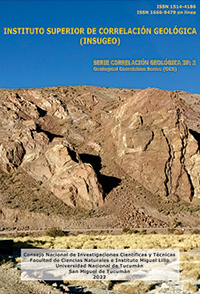Serie Correlación Geológica 38 (2)
Geodiversidad, Geoconservación y Geoturismo: caso testigo en el espacio serrano de Tandil. Consideraciones para la reflexión teórica
Descargar trabajo en formato PDFResumen
Se sistematizó un corpus de conocimiento demostrando la existencia de diferentes líneas argumentativas que articulan los conceptos geodiversidad, geoconservación y geoturismo. En pos de generar lineamientos eficaces para la conservación de la geodiversidad, a partir de la actividad turística, utilizando como caso testigo de la articulación de los elementos en el territorio al espacio serrano de Tandil. Superficie icónica dentro del Sistema Serrano de Tandilia, con una influyente actividad ecoturística mercantil, de alta demanda con óptimas condiciones para la reproducción del capital. La metodología utilizada para el desarrollo de la presente investigación constó de: análisis del inventario turístico de la ciudad de Tandil y su proclama de difusión; visitas y observación directa participante en los sitios de interés y entrevista a informantes claves. Se arriba a las siguientes conclusiones: Los elementos geodiversidad, geoturismo y geoconservación se encuentran articulados y vinculados de manera sinérgica. En el caso del espacio serrano de Tandil no se encuentran experiencias de geoturismo, que pongan en valor la geodiversidad de esta área teniendo como elemento central su conservación. Contexto que desarrolla una cierta tendencia al turismo comercial o ecoturismo mercantil y no tanto a desarrollos turísticos vinculados a los patrimonios naturales particularmente a los geológicos y por otro lado a aquellos que son históricos vinculados a la geodiversidad del territorio. En este sentido surgen conflictos en torno a antiguos espacios canteriles. Problemas derivados de tensiones desarrolladas a partir del uso del suelo de estos lugares privados, los cuales se encuentran en abandono por un cese de las actividades mineras. Pero con uso recreativo constante por parte de la comunidad local, tornándose peligroso por las características del lugar y la falta de infraestructura especializada. A esto deben sumarse, factores que complejizan la situación como los vinculados a la legislación vigente y la escasa planificación y gestión estatal. En resumen, un análisis profundo de la geoconservación yel geoturismo puede ayudar a mejorar el sistema turístico de manera sostenible y enriquecedora para todas las partes involucradas.
Abstract
GEODIVERSITY, GEOCONSERVATION AND GEOTOURISM: TEST CASE IN THE MOUNTAIN AREA OF TANDIL. CONSIDERATIONS FOR THEORETICAL REFLECTION. A body of knowledge was systematized, demonstrating the existence of different lines of argument that articulate the concepts of geodiversity, geoconservation and geotourism. In order to generate effective guidelines for the conservation of geodiversity, based on tourist activity, using the Tandil mountain area as a case study of the articulation of the elements in the territory. This is an iconic area within the Serrano de Tandilia System, with an influential ecotourism market, high demand and optimal conditions for the reproduction of capital. The methodology used for the development of the present research consisted of: analysis of the tourist inventory of the city of Tandil and its dissemination proclamation; visits and direct participant observation in the sites of interest; interviews with key informants. The following conclusions were reached: The elements of geodiversity, geotourism and geoconservation are articulated and synergistically linked. In the case of the Tandil mountain area, there are no geotourism experiences that value the geodiversity of this area, with geoconservation as a central element. In this context, there is a certain tendency towards commercial tourism or commercial ecotourism and not so much towards tourism developments linked to natural heritage, particularly geological heritage, and on the other hand to historical heritage linked to the geodiversity of the territory. In this sense, conflicts arise around ancient quarrying areas. Problems arising from tensions over the land use of these private sites, which have been abandoned due to the cessation of mining activities. But with constant recreational use by the local community, becoming dangerous due to the characteristics of the place and the lack of specialised infrastructure. To this must be added factors that make the situation more complex, such as those linked to the legislation in force and the lack of planning and state management. In summary, an in-depth analysis of geoconservation and geotourism can help to improve the tourism system in a sustainable and enriching way for all parties involved.






